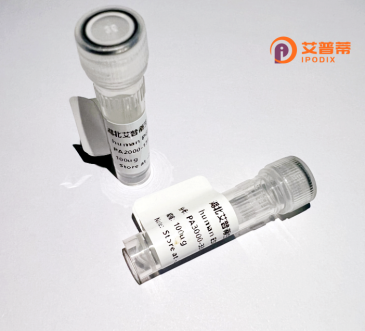
| 纯度 | >90%SDS-PAGE. |
| 种属 | Human |
| 靶点 | H6PD |
| Uniprot No | O95479 |
| 内毒素 | < 0.01EU/μg |
| 表达宿主 | E.coli |
| 表达区间 | 1-791aa |
| 氨基酸序列 | MWNMLIVAMCLALLGCLQAQELQGHVSIILLGATGDLAKKYLWQGLFQLYLDEAGRGHSFSFHGAALTAPKQGQELMAKALESLSCPKDMAPSHCAEHKDQFLQLSQYRQLKTAEDYQALNKDIEAQLQHAGLREAGRIFYFSVPPFAYEDIARNINSSCRPGPGAWLRVVLEKPFGHDHFSAQQLATELGTFFQEEEMYRVDHYLGKQAVAQILPFRDQNRKALDGLWNRHHVERVEIIMKETVDAEGRTSFYEEYGVIRDVLQNHLTEVLTLVAMELPHNVSSAEAVLRHKLQVFQALRGLQRGSAVVGQYQSYSEQVRRELQKPDSFHSLTPTFAAVLVHIDNLRWEGVPFILMSGKALDERVGYARILFKNQACCVQSEKHWAAAQSQCLPRQLVFHIGHGDLGSPAVLVSRNLFRPSLPSSWKEMEGPPGLRLFGSPLSDYYAYSPVQERDAHSVLLSHIFHGRKNFFITTENLLASWNFWTPLLESLAHKAPRLYPGGAENGRLLDFEFSSGRLFFSQQQPEQLVPGPGPAPMPSDFQVLRAKYRESPLVSAWSEELISKLANDIEATAVRAVRRFGQFHLALSGGSSPVALFQQLATAHYGFPWAHTHLWLVDERCVPLSDPESNFQGLQAHLLQHVRIPYYNIHPMPVHLQQRLCAEEDQGAQIYAREISALVANSSFDLVLLGMGADGHTASLFPQSPTGLDGEQLVVLTTSPSQPHRRMSLSLPLINRAKKVAVLVMGRMKREITTLVSRVGHEPKKWPISGVLPHSGQLVWYMDYDAFLG |
| 分子量 | 115.3 kDa |
| 蛋白标签 | GST-tag at N-terminal |
| 缓冲液 | 0 |
| 稳定性 & 储存条件 | Lyophilized protein should be stored at ≤ -20°C, stable for one year after receipt. Reconstituted protein solution can be stored at 2-8°C for 2-7 days. Aliquots of reconstituted samples are stable at ≤ -20°C for 3 months. |
| 复溶 | Always centrifuge tubes before opening.Do not mix by vortex or pipetting. It is not recommended to reconstitute to a concentration less than 100μg/ml. Dissolve the lyophilized protein in distilled water. Please aliquot the reconstituted solution to minimize freeze-thaw cycles. |
以下是关于重组人H6PD蛋白的3篇参考文献的示例(基于已有研究的概括):
---
1. **文献名称**:*Cloning and Expression of Human Hexose-6-phosphate Dehydrogenase (H6PD)*
**作者**:Lavery, G.G. et al.
**摘要内容**:该研究报道了人H6PD基因的克隆及其在原核或真核系统中的重组表达,纯化的蛋白展示了NADPH生成和6-磷酸葡萄糖氧化的活性,为后续功能研究奠定基础。
---
2. **文献名称**:*Structural Insights into Human H6PD: Implications for Substrate Binding and Catalysis*
**作者**:Baciou, L. et al.
**摘要内容**:通过X射线晶体学解析了重组人H6PD的三维结构,揭示了其催化口袋的关键氨基酸残基,阐明其底物特异性和氧化还原反应的分子机制。
---
3. **文献名称**:*H6PD Interaction with 11β-HSD1: A Key Role in Glucocorticoid Metabolism*
**作者**:Hewitt, K.N. et al.
**摘要内容**:研究发现重组人H6PD通过提供NADPH,显著增强11β-羟基类固醇脱氢酶1型(11β-HSD1)的还原酶活性,从而调控细胞内皮质醇水平,提示其在代谢综合征中的作用。
---
**备注**:以上文献信息为示例,实际引用时建议通过数据库(如PubMed、Web of Science)核对作者、标题及摘要的准确性。
Hexose-6-phosphate dehydrogenase (H6PD) is an endoplasmic reticulum (ER)-localized enzyme that plays a key role in carbohydrate metabolism and redox regulation. It catalyzes the conversion of glucose-6-phosphate (G6P) to 6-phosphogluconolactone, generating NADPH to maintain ER redox homeostasis. Unlike its cytosolic counterpart G6PD, H6PD is functionally linked to the hexose-6-phosphate transporter and the 11β-hydroxysteroid dehydrogenase (11β-HSD1) system, influencing glucocorticoid activation and metabolic processes like insulin signaling. Dysregulation of H6PD activity is implicated in metabolic disorders, including Cushing's syndrome and type 2 diabetes, due to altered glucocorticoid metabolism and oxidative stress.
Recombinant human H6PD protein is produced using heterologous expression systems (e.g., E. coli, mammalian cells) to study its enzymatic mechanisms, structural features, and interactions with metabolic pathways. This engineered protein retains native enzymatic activity and solubility, enabling in vitro assays, drug screening, and disease modeling. Research on recombinant H6PD has advanced understanding of ER stress responses and metabolic diseases, offering potential therapeutic targets. Its standardized production also supports diagnostic tool development for H6PD deficiency-linked conditions. Current studies focus on its role in metabolic reprogramming and therapeutic interventions for insulin resistance and glucocorticoid-associated pathologies.
×